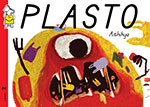Aithihya’s abstract art amply illustrates the theme and intent of this little ‘wordless’ book as the young reader is shown rather than told, about the monstrous impact of all the plastic we so thoughtlessly litter our world with. The Cyclops-like creature is the eponymous Plasto who devours our waste with voracious delight and assumes awesome proportions as its gluttony finds enough to satisfy it. Very soon the monster becomes bigger than the human beings on the page and turns into a real threat as it dominates the landscape and takes over. Since this is a book for young readers, the dystopian images are effectively balanced with a solution, the eco-warriors who valiantly cut the monster down to size as they reuse, reduce and recycle, and segregate the waste into manageable proportions. The devil is in the detail and this book demands that each page be ‘read’ carefully for the images are the text. The speed with which the monster grows is a timely warning and the carefully drawn panels on the closing pages, a clear reminder of how laborious the process of reversing this damage can be. Aithihya has chosen well to use only the power of images to tell her story and hopefully convert all the readers of the book into eco-advocates who will save the planet from the evil monster thoughtless human beings have created.The Cyclops-like creature is the eponymous Plasto who devours our waste with voracious delight and assumes awesome proportions as its gluttony finds enough to satisfy it. Very soon the monster becomes bigger than the human beings on the page and turns into a real threat as it dominates the landscape and takes over. Since this is a book for young readers, the dystopian images are effectively balanced with a solution, the eco-warriors who valiantly cut the monster down to size as they reuse, reduce and recycle, and segregate the waste into manageable proportions. The devil is in the detail and this book demands that each page be ‘read’ carefully for the images are the text. The speed with which the monster grows is a timely warning and the carefully drawn panels on the closing pages, a clear reminder of how laborious the process of reversing this damage can be. Aithihya has chosen well to use only the power of images to tell her story and hopefully convert all the readers of the book into eco-advocates who will save the planet from the evil monster thoughtless human beings have created.
November 2023, volume 47, No 11

